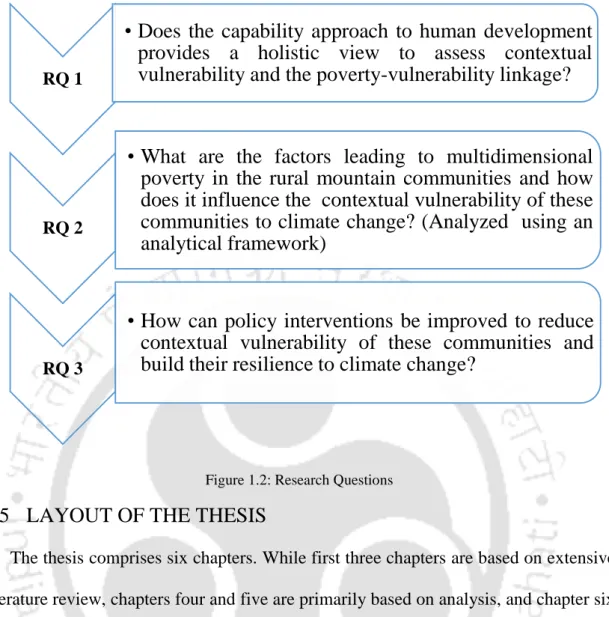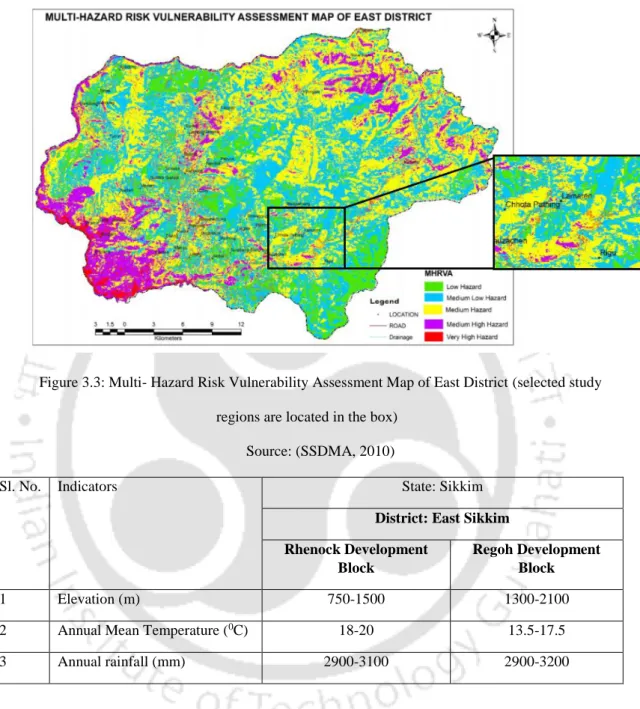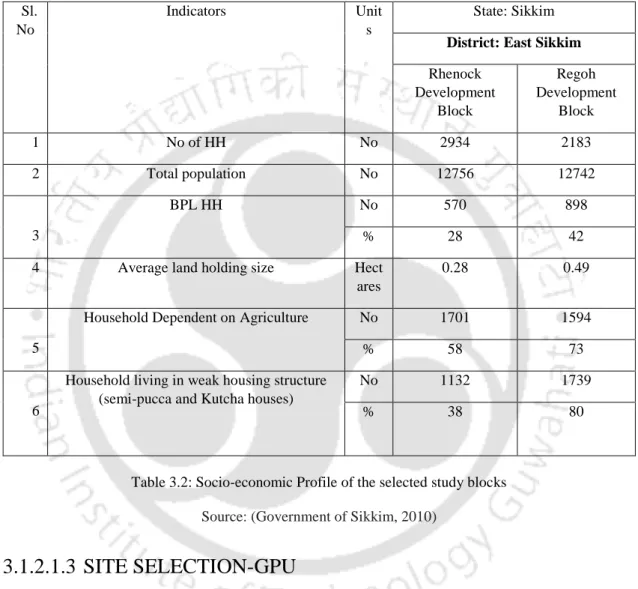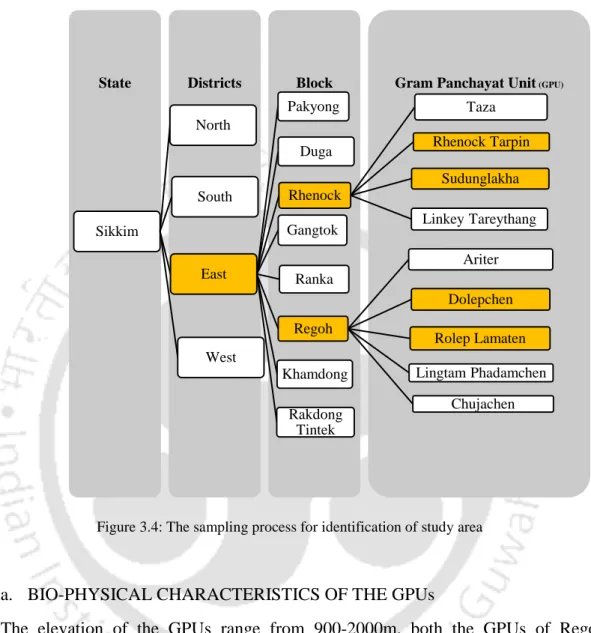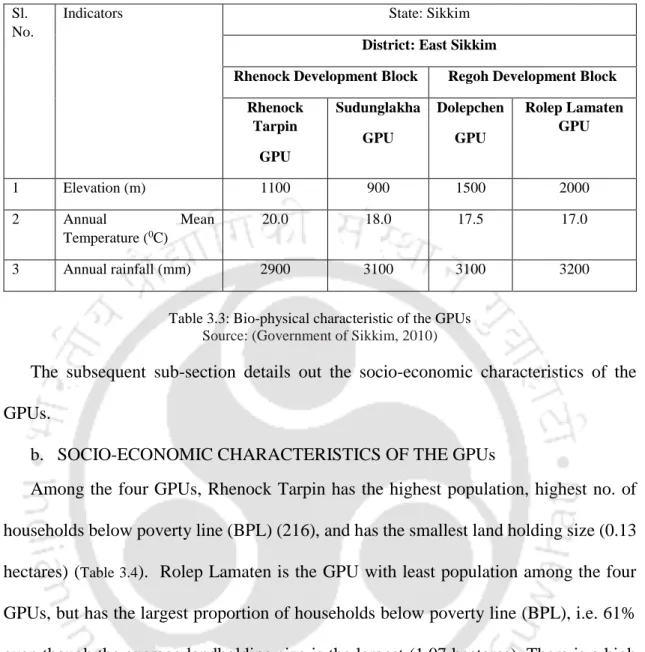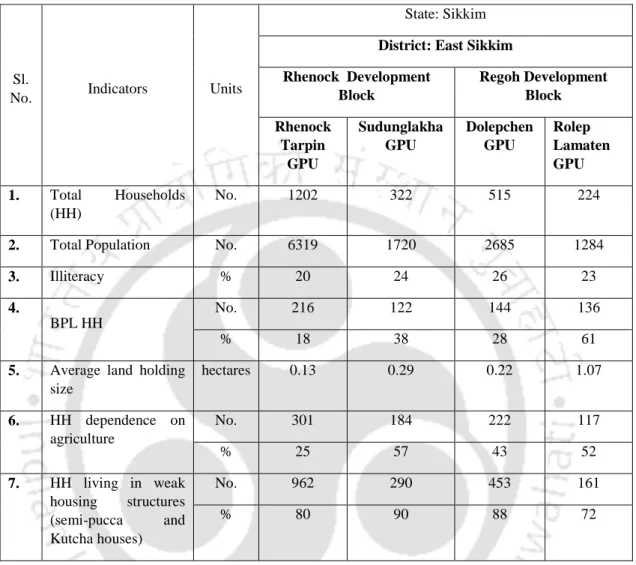Climate change and adaptation through the lens of capacity approach: A case study from the Eastern Himalayas. Adaptation to climate change through capability approach: A case study from Eastern Himalayan” Paper presented at the HDCA Annual Conference, September 10-13, 2015, Washington DC, USA.
CLIMATE CHANGE, VARIABILITY, AND VULNERABILITY
This particularly emphasizes the importance of vulnerability assessment for planning adaptation strategies to climate change. However, the most consistent definition of vulnerability in the context of climate change is "the degree to which a system is susceptible to, and unable to cope with, adverse effects of climate change, including climate variability and extremes" (IPCC, 2007a).
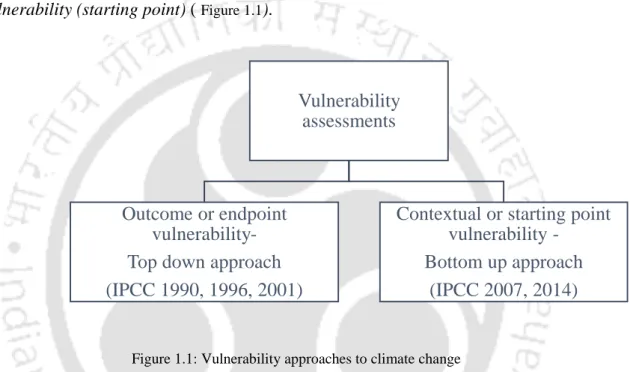
CONTEXTUAL VULNERABILITY AND MULTIDIMENSIONAL POVERTY
This approach views vulnerability as a current lack of adaptive capacity to changing climate conditions (Okpara et al., 2016). Adaptive capacity is the ability to conserve the existing resources and improved adaptive capacity builds resilience, which includes the ability to acquire new capacities to emerge from adverse impacts of climate change (Wong-Parodi et al., 2015).
RESEARCH AIM
Based on this discussion, the research objective and research questions were formulated, which are discussed in the following paragraphs. The research objective is achieved through a series of research questions stated in the following subsection.
RESEARCH QUESTIONS (RQ)
LAYOUT OF THE THESIS
The third chapter presents discussions of the data and the research methodology used for conducting the multidimensional poverty assessment to determine the contextual vulnerability of the rural mountain communities of Sikkim (RQ2 and RQ 3). The chapter focuses on the interventions made in each of the multidimensional poverty themes in the context of the capability approach to human development to suggest how the interventions can be improved to reduce contextual vulnerability of these communities and their resilience against climate change to build.
CLIMATE CHANGE VULNERABILITY ASSESSMENTS
As discussed in section 1.2, the physical and social impacts of climate change are not uniform or homogeneous, as the magnitude and direction of climate change vary across the world and even within the same region experiencing climate change is likely to vary because some ecosystems, economic sectors, or social groups are more vulnerable to climate change than others (O'Brien et al., 2004). Since socio-economic vulnerability dimension has been investigated to a lesser extent than the bio-physical vulnerability, the focus of this research is on assessment of socio-economic vulnerability (i.e. the contextual vulnerability).
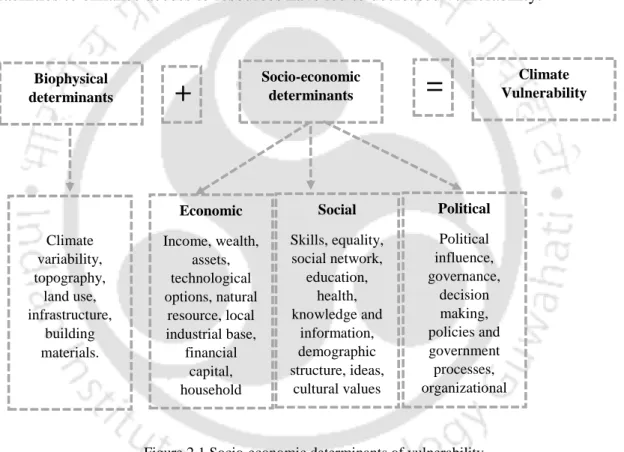
MULTIDIMENSIONAL POVERTY AND VULNERABILITY
These studies argue that to reduce the vulnerability of individuals and communities by increasing their resilience, it is important to plan pro-poor interventions, taking into account the multidimensional nature of poverty. Therefore, it is important to understand the institutional constraints imposed on the members of society (such as gender discrimination, lower castes or religious groups) that prevent them from evaluating education and jobs with better returns (Unni, 2009b).
HUMAN DEVELOPMENT APPROACH TO VULNERABILITY ASSESSMENTS
THE CONCEPTUAL FRAMEWORK
Therefore, it is essential to have the freedom to choose the government and to participate in the functioning of the government to reduce vulnerability. Transparency in the system of governance can be instrumental in the process of achieving political freedoms together with economic development of society.
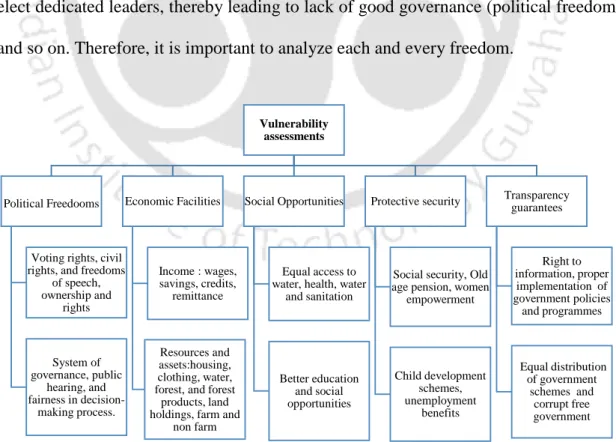
SUMMING UP
The chapter dwells on the methodological steps for assessing contextual vulnerability based on a human development approach. Since the human development approach establishes the link between multidimensional poverty and contextual vulnerability, the chapter describes the process of estimating the extent of rural multidimensional poverty in mountain communities (RQ 2).
CONTEXTUAL VULNERABILITY ASSESSMENT: MULTIDIMENSIONAL
BACKGROUND OF THE STUDY AREA
Most of the farmers in the state practice subsistence farming as the land holdings are small (1-2 hectares) or marginal (less than 1 hectare). Land for agriculture is very scarce as only 11% of the land in the state is arable (Government of Sikkim, 2014).
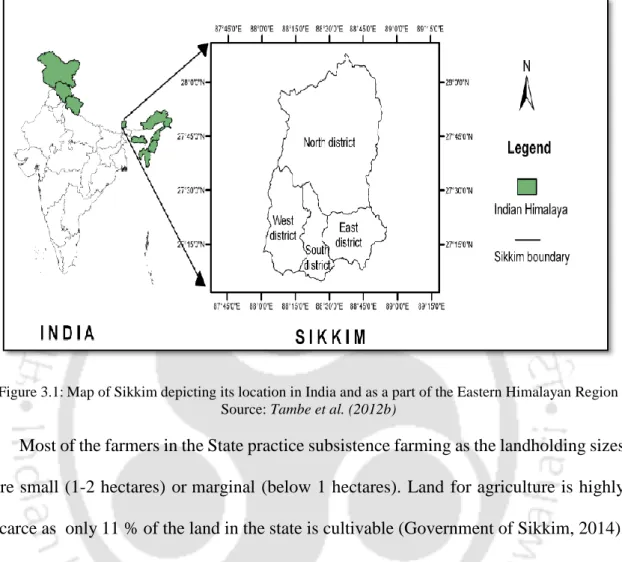
SAMPLING METHODS AND PROCEDURE
About 45% of the total workers (main and marginal workers) in the state are employed in the eastern district (308138 in number). To conduct 4 FGDs in each of the 4 GPUs, several representatives were selected from the GPUs.

DATA COLLECTION METHODS AND TECHNIQUES
Political freedoms: Freedoms to participate in planning and implementation of water schemes such as rural water supply, domestic water supply etc. Political freedoms: Freedoms to participate in planning and implementation of social safety nets such as national health mission, functioning of public health centers. Political freedoms: Freedoms to participate in the planning and implementation of social safety nets such as total sanitation campaign.
Political Freedoms: Freedoms to participate in planning and implementation of non-agricultural schemes like MGNREGA, Self Help Groups etc.
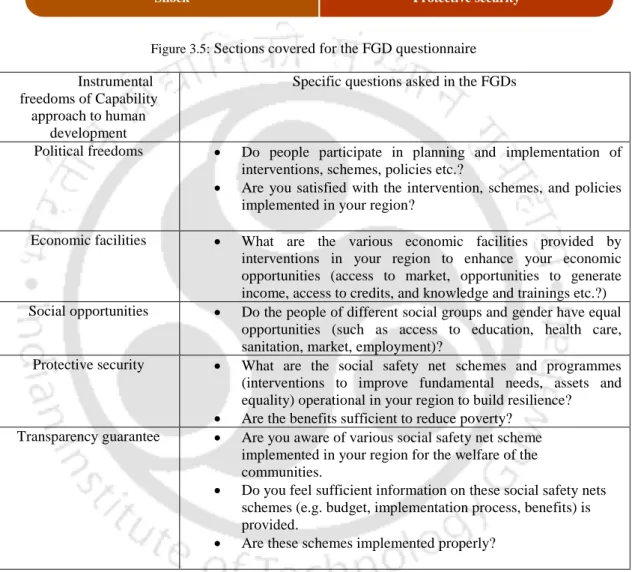
FIELD SURVEY
A household survey covering a sample of 140 households in four GPUs was conducted with the help of field facilitators of RMDD, Government of Sikkim. The interview schedule consisted of questions corresponding to subcomponents of the 10 MPAT topics described in The relative importance (weights) of subcomponents and indicators was adopted from the MPAT framework.
Consultations were held with experts from RMDD, Government of Sikkim, academia and the local community on the importance of weights in the context of East Sikkim prior to data collection.

METHOD USED IN DATA ANALYSIS
In the second step, this scaled score of the response to survey questions (indicators) for each subcomponent and the weights attached to the respective survey questions wik (in %) were aggregated by estimating the weighted arithmetic mean (Table 3.10 and Equation 1) ). Geometric weighted average is preferred in the final step compared to arithmetic weighted average because it pulls the index score to the lower value, which should be emphasized; this aspect is important as the research is about multidimensional poverty and is aimed at identifying the themes that require emphasis to reduce contextual vulnerability (Saisana and Saltelli 2010). The chapter presents multidimensional poverty assessments at the district level to prioritize themes that reflect the highest levels of poverty and require immediate attention through interventions to reduce vulnerability in the district.
The discussion is based on a quantitative and qualitative analysis of the extent of multidimensional poverty in selected rural hill communities in East Sikkim district and the impact of multidimensional poverty on the contextual vulnerability of these communities (RQ2).
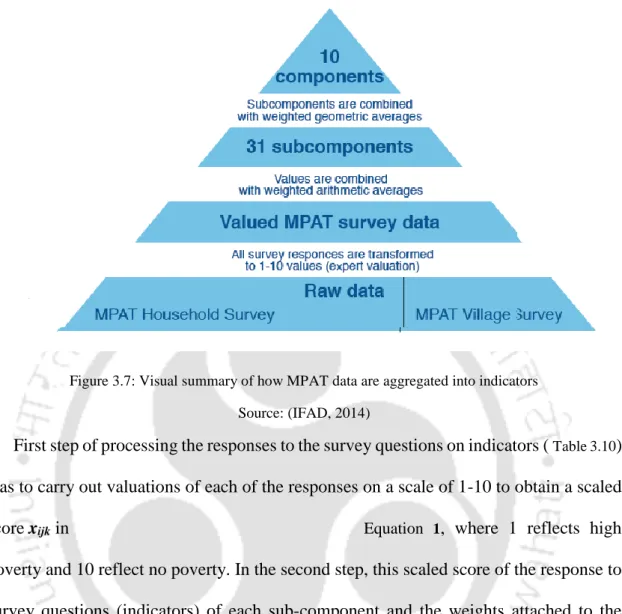
PRIORITY THEMES TO REDUCE VULNERABILITY: MULTIDIMENSIONAL
HIGH POVERTY (30-60%)
The order of the themes is therefore – (1) farm assets, (2) education, (3) non-farm assets, (4) health and healthcare, (5) exposure and resilience to shock, (6) food and nutrition security. But many of the respondents expressed that the scale of livestock raising (poultry, pig farming, dairy farming). This is evident in the MPAT score of 38% for the sub-component, degree of exposure, of the district.
These have limited the ability of local communities to cope with and recover from the impacts of natural disasters (Table 4.2).
MODERATE POVERTY (60-80%)
Food and nutrition security in the district is deficient because survey respondents expressed that they were unable to participate in the design of social security schemes to suit the context of the district. There are differences in hygiene practices of households from different social groups with extreme poverty among OBC households (29%), followed by ST households (34%) and general category households (42%) (Table 4.3). Firewood is collected with permission from the Department of Forests, Government of Sikkim.
Most of the household have piped drinking water connections under the Rural Water Supply Program (RWSP), Government of Sikkim.
SUMMING UP
Findings from the field show that the majority of households (80%) depend on agriculture for their livelihood, despite agricultural production stagnating due to difficult topography, small and fragmented holdings, limited irrigation and a lack to agricultural production. mechanization and the frequent occurrence of natural disasters such as landslides, floods and earthquakes (Government of Sikkim, 2011a, Government of Sikkim, 2014), resulting in low and uncertain income among the communities. Furthermore, communities felt that despite the few opportunities available in the region, communities lacked the skills to reap the benefits of such opportunities. Similarly, the culture of early marriage has limited the female child's achievements in the region.
Similarly, the majority of respondents were of the opinion that decision-making power rests primarily with male family members.
PRIORITY THEMES TO REDUCE VULNERABILITY: MULTIDIMENSIONAL
HIGH POVERTY (30-60%)
Among the four GPUs, Rhenock Tarpin has the highest poverty of agricultural assets (40%), while Rolep Lamaten has the lowest poverty (46%) (Table 5.1). Dolepchen GPU has the highest educational poverty (34%), while Rolep Lamaten GPU has the least among the 4 GPE (49%). Achievements in the field of health and healthcare in the four GPEs are moderate to high poverty (Figure 5.5).
Dolepchen GPU has the highest poverty in terms of exposure and resilience to shocks (42%), while Sudunglakha has the least poverty (63%) (Table 5.1).
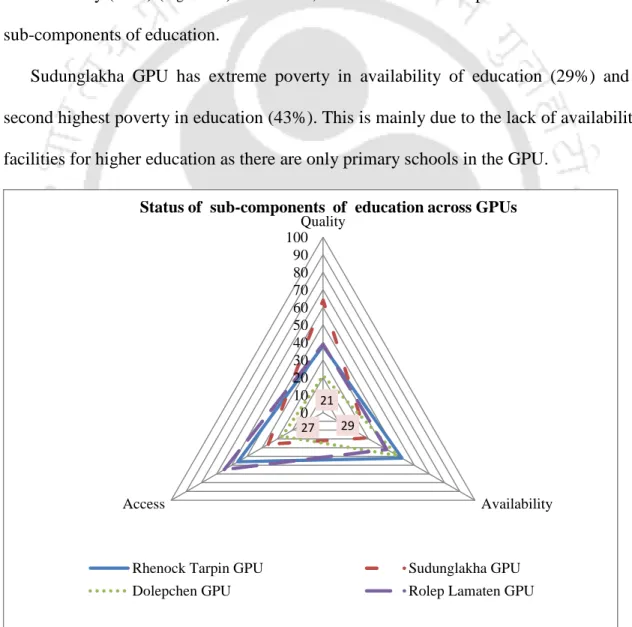
MODERATE POVERTY (60-80%)
Among the GPUs, the highest poverty was in Sudunglakha (64%), while the least poverty was in Rhenock Tarpin (71%) and Rolep Lamaten (71%). Despite the high exposure of the district to hazards (earthquake and landslides), most of the communities live in poor housing structure only 20% in Rhenock Tarpin live in pucca house, 10% in Sudunglakha, 12% in Dolepchen, while ' a relatively higher percentage (28%) in Rolep Lamaten live in Pucca houses (Figure 5.9). This is reflected in the MPAT score of all the GPUs (Figure 5.1). Dolepchen GPU has the highest household water supply poverty among the GPUs (71%), while Rhenock Tarpin has the least (80%) (Figure 5.1).
Among the sub-components, respondents from Rolep Lamaten expressed that GPU has the worst quality of domestic water supply (65%), Dolepchen GPU has the lowest availability (75%) and access (65%) (Figure 5.10).
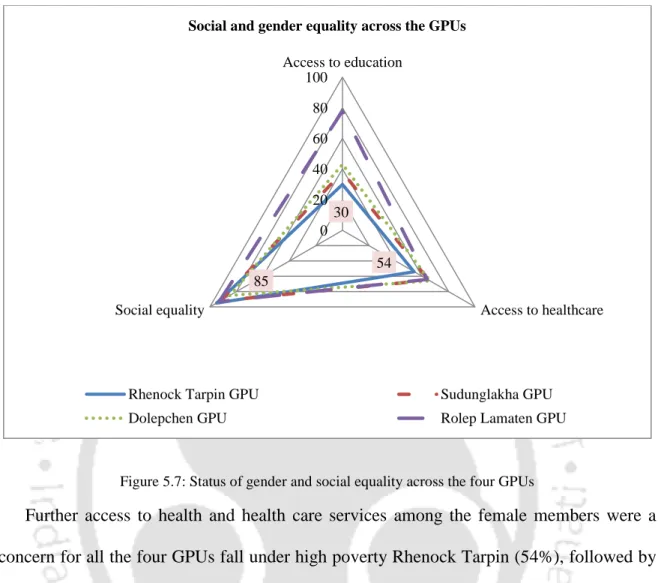
SUMMING UP
However, the main concerns about the four GPUs were the extreme poverty (0-30%) in the land tenure subcomponent (land tenure, type of ownership). Another area of concern where all the four GPUs suffer from extreme and high poverty is the education sector. Similarly, quality of treatment under health and healthcare theme is a major concern in all the four GPUs.
Low achievement in the above MPAT themes (lack of agricultural and non-farm assets, low education, poor health status and other resources that are essential for adaptation) has resulted in low capacity to cope and recover any unexpected occurrence. of natural disasters in all four GPUs.
REVISITING THE RESEARCH QUESTIONS
UNDERSTANDING ON POVERTY-VULNERABILITY LINKAGE (RQ 1)
Adaptation to climate change plays a critical role in these economies, as the poor and the marginalized in these economies are at greater risk of climate change impacts. Mainstreaming climate change policies is a crucial tool to ensure that climate change adaptation and human development are implemented hand in hand (UNDP, 2011). What factors lead to multidimensional poverty in rural mountain communities and how does it affect the contextual vulnerability of these communities to . climate change?).
Sikkim was selected to conduct the multidimensional rural poverty assessment of hill communities because it is characterized by a multitude of ethnic minorities, tribes and clans, where dependence on natural resources is high and the effects of climate change are likely to magnify the risk they face .
POLICY INTERVENTIONS TO REDUCE CONTEXTUAL
A framework for assessing the vulnerability of Canadian Arctic communities to climate change-related risk. Contribution of Working Group I to the Third Assessment Report of the Intergovernmental Panel on Climate Change. Contribution of Working Groups I, II and III to the Fourth Assessment Report of the Intergovernmental Panel on Climate Change.
Contribution of Working Group II to the Fifth Assessment Report of the Intergovernmental Panel on Climate Change [Field, C.B., V.R. Climate Change and Sustainability of Agrodiversity in Traditional Agriculture in the Sikkim Himalaya (Gangtok: Information and Public Relations Department, Government of Sikkim). Integrating local hybrid knowledge and government support for climate adaptation in the Asian highlands.
WAY FORWARD ......................................................... Error! Bookmark not defined
